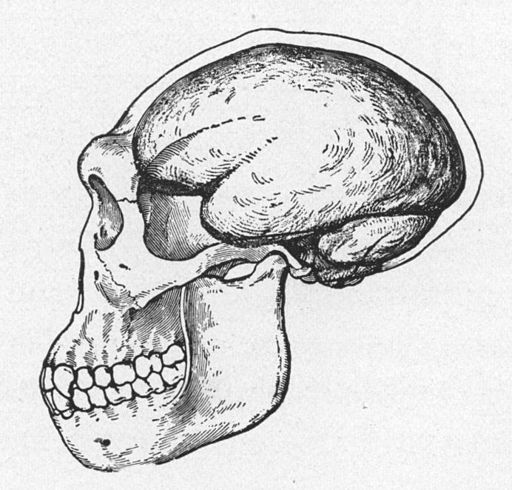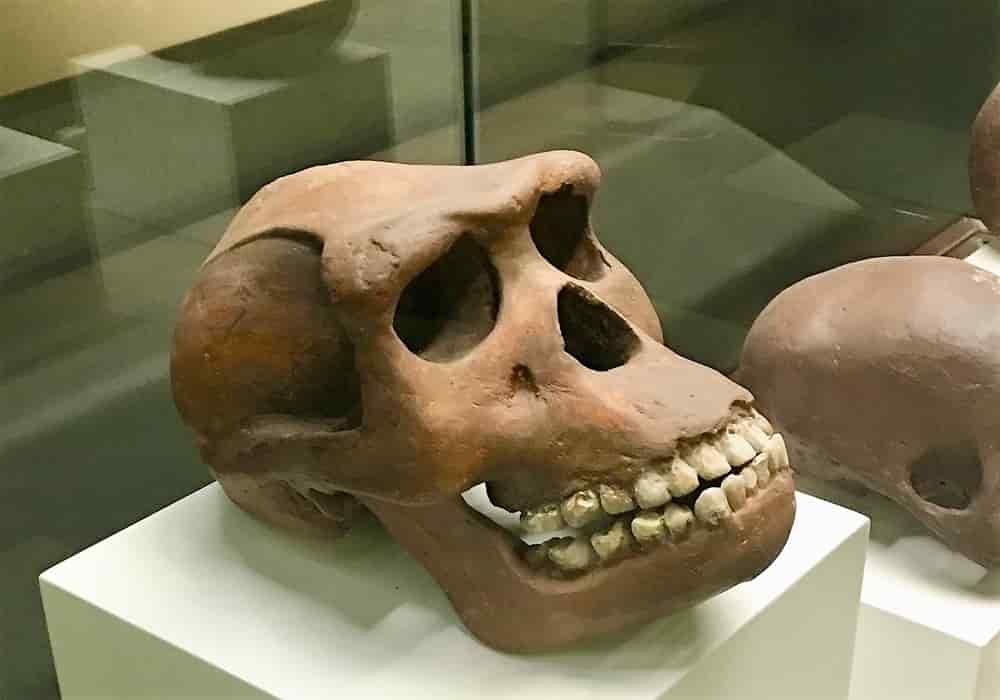Java Man
Java Man (Homo erectus erectus, formerly also Anthropopithecus erectus, Pithecanthropus erectus) is the name given to a fossil found in 1891 in Trinil, Ngawi Regency, on the banks of the Solo River in East Java, Indonesia, one of the first known Homo erectus specimens. It is also known as pithecanthropus, from the scientific name given to its discoverer, Eugene Dubois, whose name derives from Greek and Latin roots and means ‘upright ape man’. Eugene Dubois named it Anthropopithecus erectus (1892-1893) and later named it Pithecanthropus erectus (1893-1894).
Features
It had a cranial capacity of about 940 ml, intermediate between the 1200-1500 of modern man and the 600 ml of the gorilla . Java man possessed the portion of the brain that controls language, although whether he actually spoke is unknown. Java man’s brain was much larger and with a greater number of convolutions than that of any primitive or living ape, and had more human than ape-like characteristics, but was smaller than that of later specimens of Homo erectus.
The femur is thicker than that of a modern human, indicating that it ran. The skull was characterized by thick bones and a receding forehead. The large teeth made the jaw large and protruding, with the lower lips protruding at the lower margin of the jaw, and the eyebrows were straight and large. It had human-like teeth with large canines. The adult Javanese man measured about 1.70 meters, weighed about 70 kilograms and walked in an upright position. He possibly moved in small family groups, lived in caves and hunted in the forests.
Judging from anatomical and archaeological evidence, as well as the ecological role of Java man, vertebrate meat was probably an important part of his diet. Java man, like other Homo erectus, was probably a rare species. There is evidence that Java man used shell tools to cut meat. The dispersal of Java man across Southeast Asia coincides with the extinction of the megalochelys giant tortoise, possibly due to overhunting, as the tortoise would have been an easy and slow target that could have been stockpiled for quite some time time.
Homo erectus used fire systematically, and the position of the bones of the calcined animals gives information to determine that they were roasted and eaten inside the cave. The mastery of fire was a crucial advance for humanity, aside from cooking food, in facilitating gathering around a campfire, which stimulated greater communication and social cohesion and helped structure more cohesive group complexes.
Date
Homo erectus inhabited Earth between about 2 million years and 400,000 years ago, lived mainly in Asia and possibly Europe as well, and arrived in Eurasia about 1.8 million years ago, in what is thought to be the first African exodus. There is evidence that the Javan Homo erectus population lived in a forest habitat that resembled a wet savanna. Plants found at the Trinil excavation site include grass (Poaceae), ferns, Ficus and Indigofera which are characteristic of lowland rain forests.
Around 400,000 years ago, Homo erectus practically disappeared except for a place called Ngandong, on Java, on the Asian continent. The most recent specimen is Homo erectus soloensis found along the Solo River in Java, which is between 117,000 and 108,000 years old, and coincides with the beginning of the interglacial era. They didn’t coincide in time with Homo sapiens, but they could do with the Denissova hominin.
The main fossil of Java Man, the skullcap which is cataloged as Trinil 2, has been biostratigraphically dated, linking it to a group of animal fossils found near the same geological horizon and compared with other assemblages of creatures that are layered and chronologically classified. Gustav Heinrich Ralph von Koenigswald first assigned Java Man to the Trinil fauna, a collection of fauna he collected from several Javanese sites and concluded that the skullcap is about 700,000 years old, thus dating to the early Middle Pleistocene.
New dating methods show that Javanese Homo erectus is much earlier than previously established and is about 1.8 million years old.
The remains, along with other fossils from the excavation, are at the Nederlands Centrum voor Biodiversity Naturalis.
Dating and debates
The fossils discovered by Eugène Dubois were estimated to be around 700,000 years old by the German-Dutch researcher Gustav von Koenigswald in the 1930s. Then studies proposed an age of between 1 million and 700,000 years, which remained for a long time. admitted9. In 2014, a new study dated the geological layer of Trinil 2 between 540,000 and 430,000 years old.
The Trinil 2 fossil remains attributed to the species Homo erectus, but the two molars were reassigned in 2019 by the French researcher Clément Zanolli to the species Meganthropus palaeojavanicus, which would not be part of the Hominina subtribe.
The femurs and fragments of femurs appear very modern to several researchers, who wonder if some of them are not rather Homo sapiens femurs, introduced by geological reworkings in the stratigraphic layer of the Trinil 2 skull cap, at unless they were found in a distinct geological layer. The debate is still unresolved to this day.
Indonesia asks for the return of the Ancient Javanese Man
Ethnology – : Indonesia, a former Dutch colony, has asked the Netherlands to return eight works of art and natural history collections from several Dutch museums, including famous people from Java, the Dutch government said Tuesday 18/10/22. Java Man, recognized as the first Homo erectus ever excavated, consists of fossil remains found in 1891 and 1892, by the Dutchman Eugene Dubois, in Java. His remains are on display at the Naturalis Museum of Natural History in Leiden.

1922 reconstruction of a Java Man skull, due to Trinil 2 being only a cranium, Dubois who believed Java man was transitional between apes and humans, drew the reconstruction with an ape-like jaw but a brain larger than apes. J. H. McGREGOR, Public domain, via Wikimedia Commons
Java Man isn’t that old after all
The oldest human remains from Southeast Asia (Java Man) are not as old as previously thought.
A team of Indonesian and Japanese scientists have overturned a decades-old estimate of Homo erectus remains from central Java in Indonesia, slashing the age of the globetrotting hominid, the first to have dispersed outside of Africa.
Header image: the most complete skull of Javanese Homo erectus found so far. (Hisao Baba/ Tsukuba National Museum of Nature and Science)
The new estimate puts the fossilized Sangiran Dome Homo erectus at around 1.3 million years ago, and certainly no earlier than 1.5 million years ago.
That’s at least 300,000 years younger than a previous, old estimate from the 1990s, which suggested the oldest Homo erectus remains at Sangiran could be up to 1.8 million years old.
However, the age has remained controversial, because some studies have come up with much younger estimates for Homo erectus at Sangiran, ranging from 1.3 to 0.6 million years old.
To determine whether the fossils were older or younger, Shuji Matsu’ura of the National Museum of Nature and Science in Tsukuba City, Japan, and his colleagues used two separate dating techniques that had not been previously used on the site.
According to Masayuk Hyodo of the University of Kobe (Japan), lead author of the study:
It was exciting to know what timeline would be determined by the new method.
Uranium-lead dating, which measures the age of crystallization, and fission dating, which determines the age of the volcano’s eruption, of zircon grains show that the volcanic ash just beneath the fossiliferous layers does not are only 1.3 million years old.
The younger age of first appearance at Sangiran matches other remains from Java dated to 1.49 million years ago.
It also puts aside the idea that the birthplace of Homo erectus could have been in Southeast Asia. It now seems much more likely that Homo erectus originated in Africa and spread across Georgia into the Caucasus, where the oldest remains of Homo erectus at 1.85 million years old have been found. From there they dispersed to Asia.
Sources: PinterPandai, Britannica, National Geographic, UNESCO, Talk Origins, Science
Photo credit: PinterPandai.com



